The first day of Redpanda Streamfest was a wealth of insights on how the industry can build AI simply, efficiently, and responsibly. On its second day, the focus was on helping data engineers and architects level up their data streaming expertise for real-time applications, analytics, and AI (of course).
Today’s attendees were in for a real treat, with the next five hours packed with a combination of cool engineering feats, product updates, customer case studies, and panels channeling community knowledge and experiences.
Without further ado, here’s what happened on day two.
Welcome keynote
We kicked off with Jennifer Lawrence, our Chief Revenue Officer, with a brief introduction on how Streamfest is set up and…
The first day of Redpanda Streamfest was a wealth of insights on how the industry can build AI simply, efficiently, and responsibly. On its second day, the focus was on helping data engineers and architects level up their data streaming expertise for real-time applications, analytics, and AI (of course).
Today’s attendees were in for a real treat, with the next five hours packed with a combination of cool engineering feats, product updates, customer case studies, and panels channeling community knowledge and experiences.
Without further ado, here’s what happened on day two.
Welcome keynote
We kicked off with Jennifer Lawrence, our Chief Revenue Officer, with a brief introduction on how Streamfest is set up and a reminder to participate in polls and AMAs to win some famous swag. She then jumped straight into the good stuff and welcomed our CTO, Tyler Akidau, who brought everyone into the Redpanda mindset with our four product values:
- **Simple: **Make the complex easy
- Efficient: Get the most out of your hardware
- Interoperable: Fit into existing stacks. No lock-in
- **Safe: **Be a reliable steward of your data.
These values not only guide how we build our products, but also define how we show up for our customers.

An Elvis Presley quote that sums up Tyler’s keynote
It’s in our DNA to focus on simplicity and efficiency — to build with builders in mind, so they can keep pushing the boundaries of what’s possible with data. Now with AI as the north star, these principles are more important than ever.
“Our goal at Redpanda is to make data streaming as simple, efficient, and safe as possible — for humans and AI alike.”
And with that, Tyler passed the stage over to Noah Watkins to show one of the many ways we’re walking the talk.
Product demos
Head in the cloud: Stream smarter with object storage
Noah Watkins, Software Engineer, Redpanda
High-throughput streaming is expensive in the cloud thanks to cross-availability zone (AZ) data transfer costs. But many organizations have workloads that don’t need instant replication across AZ boundaries, like for log collection or analytics, and would happily exchange slightly higher latencies for lower networking costs.
Meet Redpanda’s Cloud Topics, a new storage tier within the Redpanda platform that lets you mix and match different topics within the same cluster to optimize each workload for latency, cost, or performance. With Cloud Topics, each batch of messages is passed straight through and written to cost‑effective object storage, so you can pay object‑store prices for replication when you don’t need lightning-fast performance.
Same durability. No cross-AZ costs.
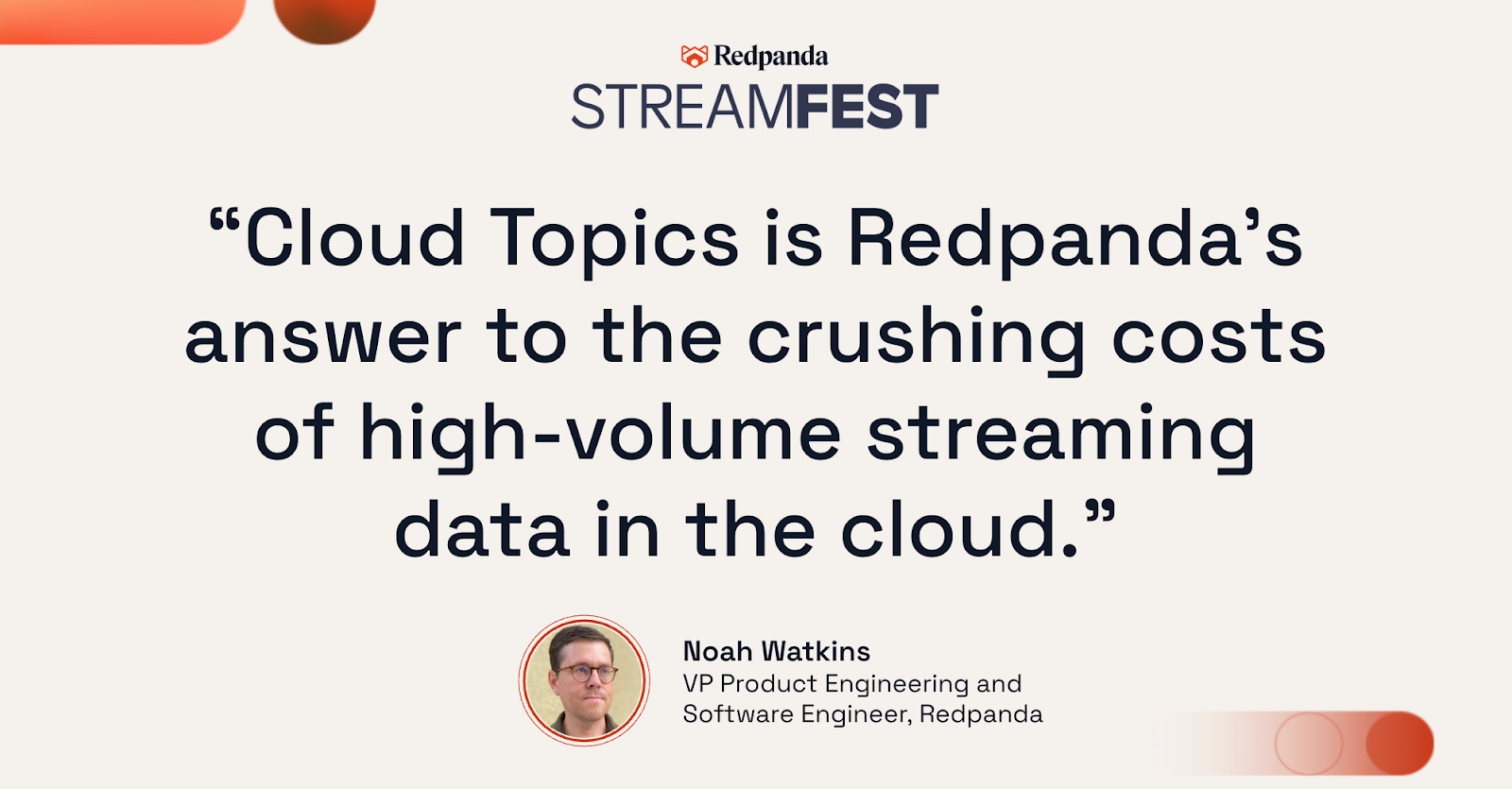
In his demo, Noah shows how to adjust Redpanda topics so you can save on your cloud bill based on your data streaming requirements, all within a single platform. In a nutshell, for lower latency, use standard topics. For lower costs, go with Cloud Topics. Neat, right?
Cloud Topics will be available in November 2025, with GA expected in March 2026. You can read how we built Cloud Topics on our blog.
Topics are the Table: Redpanda meets Iceberg
Nicolae Vartolomei, Engineer, Core Storage, Redpanda
On the topic of…topics, this session zooms in on Redpanda’s native Apache Iceberg™ integration: Iceberg Topics. This integration makes accessing your streaming data radically more efficient by letting you store streaming data directly in the Iceberg open table format, making it instantly available for downstream analytics. (ETL, who?)
In this demo, Nicolae demonstrated this powerful integration with a manufacturing use case where he captured sensor events from a factory floor, landed them in Redpanda, translated them from stream to table using AWS Glue Catalog, and then queried them.
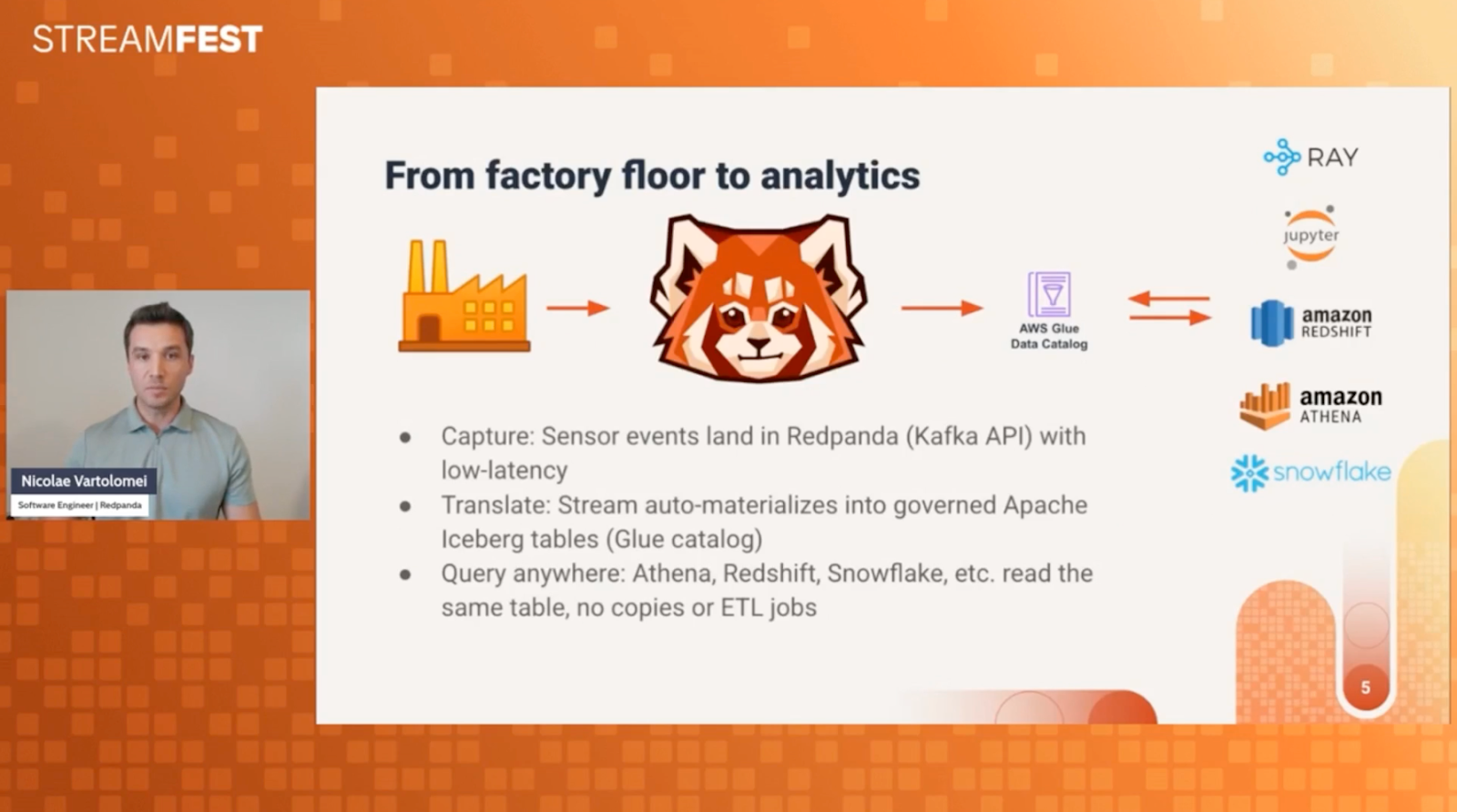
Example architecture to demonstrate Redpanda’s Iceberg Topics
As with most things in Redpanda, it’s as easy as pushing a button. Iceberg Topics is currently available on all major clouds (AWS, Azure, GCP) and requires an enterprise license. Watch Nicolae’s session to see it in action.
Don’t panic! Reliably shadowing your streaming data for disaster recovery
Trevor Blackford, Senior Product Manager, Platform, Redpanda
Here’s a nice thought: Since 2025, every major cloud provider has had a major outage.
Turns out that highly available architectures can still fail. For mission-critical applications, you’ll want a multi-region approach to disaster recovery (DR). To put it in Trevor’s words, imagine your cluster is working on figuring out the meaning of life, the universe, and everything. If a Vogon fleet came and destroyed the cluster’s region, you’d lose it all and would have to build a new custom planet — unless your data had been copied to a safe place.
Well, Redpanda has a new feature that enables just that. (As in copying your data to a safe place. Not finding the answer to the universe, which everyone knows is 42.)
Say hello to Shadowing, the ability to link different Redpanda clusters together. In the Vogon scenario, instead of starting over, you’d simply failover the topics and redirect your producers to the Shadow cluster, which now accepts writes. Crisis averted.

Slide explaining Redpanda’s new Shadowing feature
Setting up Shadowing in Redpanda Console only takes three simple steps, which you can see in his full demo, so go check it out.
Under new management: Migrating to BYOC
Trevor Blackford, Senior Product Manager, Platform, Redpanda
Remember the saying, “Don’t put all your eggs in one basket”? Unfortunately, many companies put all their eggs in one cloud, leading to some spectacular outages.
A multi-cloud strategy is the solution, but managing apps across multiple clouds is a pain. Our solution? Bring-your-own-cloud (BYOC). Redpanda manages the parts you don’t want to deal with, and you keep full control over your data. That means your engineers won’t lose their hair, and your applications stay safe in the event of a disaster.
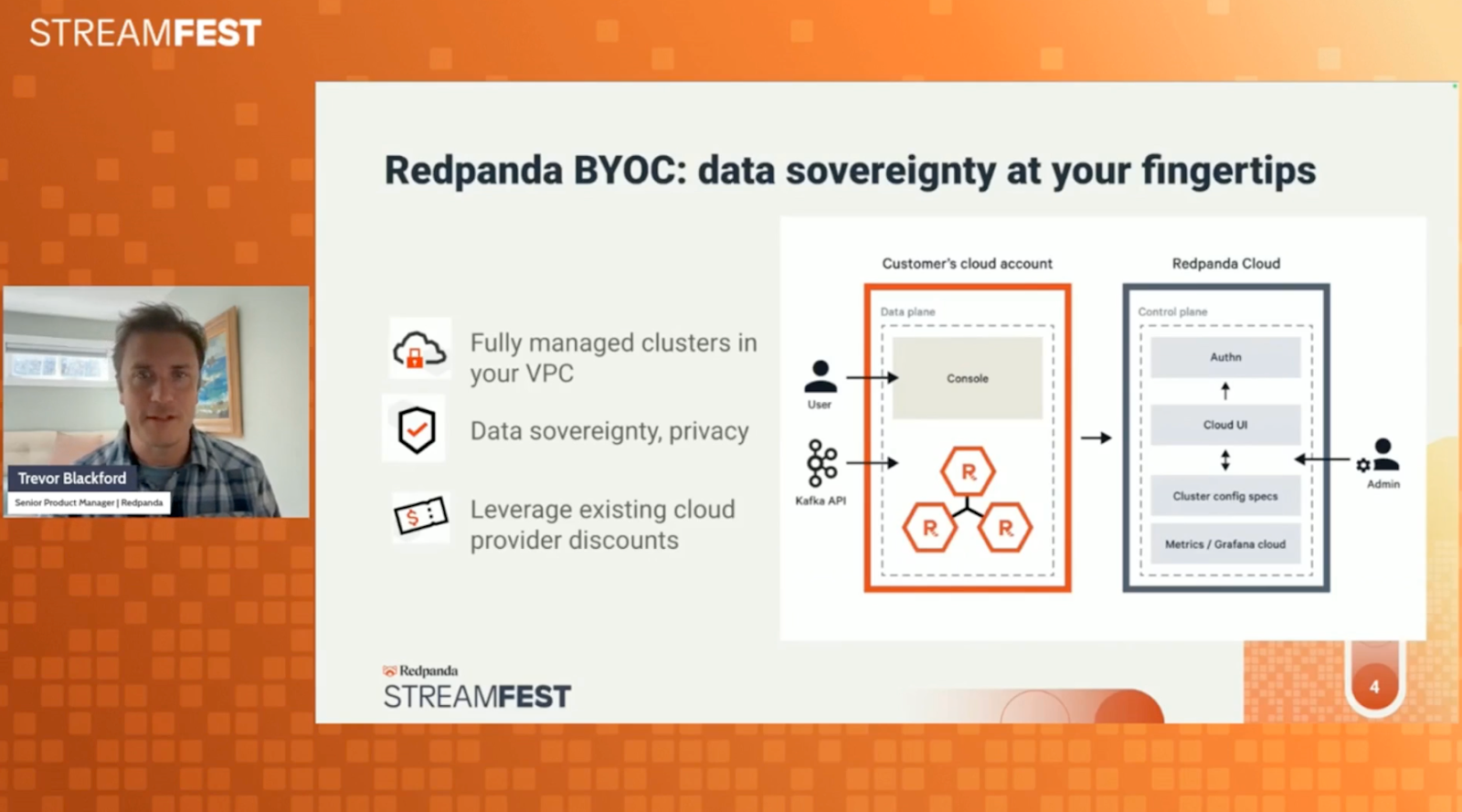
BYOC offers both privacy and fully managed services
Okay, but what about the stress of migrating your data to BYOC? Trevor’s first session showed you how to set up Shadowing. In this session, he reveals another exciting advantage of this new feature: smoothly migrating your clusters without the hassles of MirrorMaker.
With Shadowing, you can move your consumers to a new cluster without moving your producers, reducing the risk of downtime. How? Glad you asked. Check out his full demo for an early preview.
Real-time SQL server changes with Redpanda Connect
Joe Woodward, Software Engineer, Connect Team, Redpanda
Redpanda Connect is our quick and easy connectivity suite that features a huge collection of sources, sinks, and processors to power real-time data and AI pipelines with little to no code.
In his session, Joe walked attendees through how Redpanda Connect now captures every change from Microsoft SQL Server in real time, with minimal impact on the source database. It’s essentially change data capture (CDC) with fewer moving parts, so teams can start streaming changes into Redpanda and stand up new services and analytics — fast.

CDC for Microsoft SQL with Redpanda and ClickHouse
If you’re just getting familiar with CDC, how it works, and want someone friendly to show an example use case, then Joe’s demo is for you.
To jump right in and take the CDC for Microsoft SQL for a spin, get started with Redpanda Connect.
Public when you want it, private when you need it: Redpanda Serverless + AWS PrivateLink
Towfiqa Yasmeen, Product, Redpanda Cloud, Redpanda Chris Chapman, Software Engineer, Redpanda
To cleanse your mental palette, Towfiqa took the stage with her boundless optimism and a presentation on every developer’s favorite: Redpanda Serverless.
For the uninitiated, Redpanda Serverless is the fastest way for developers to start streaming data. You can spin up a cluster in a click, and there’s no infrastructure to deploy or systems to configure. Just fully managed services where you can pay as you go and scale as you grow.
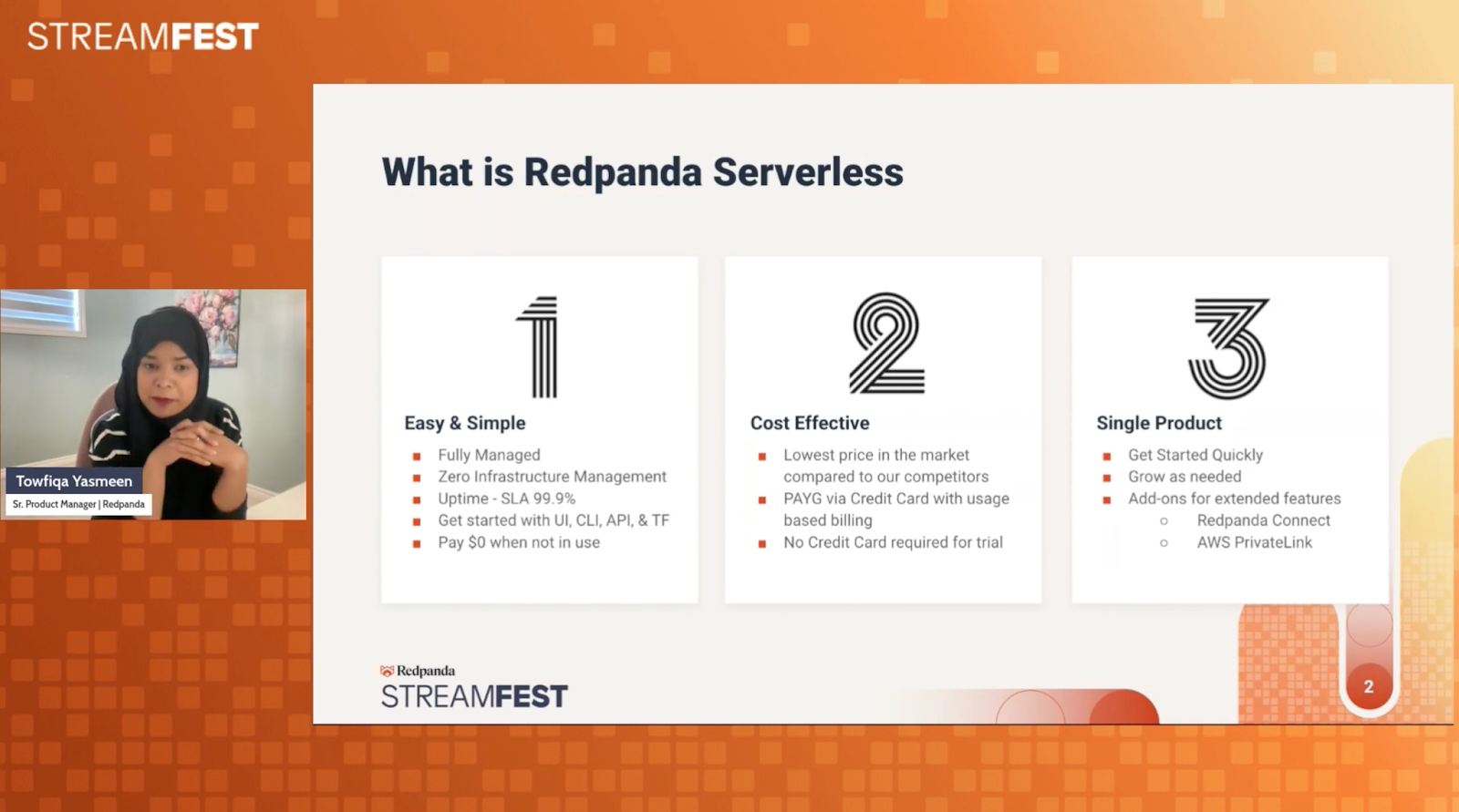
The benefits of Redpanda Serverless
Sounds too good to be true? Some would argue that serverless streaming isn’t all that secure. But Towfiqa and Chris are here to prove that serverless doesn’t have to mean “public networking only.” In fact, Redpanda Serverless is currently the only serverless offering that lets you choose whether you want your cluster to be public or private without an upgrade or migration.
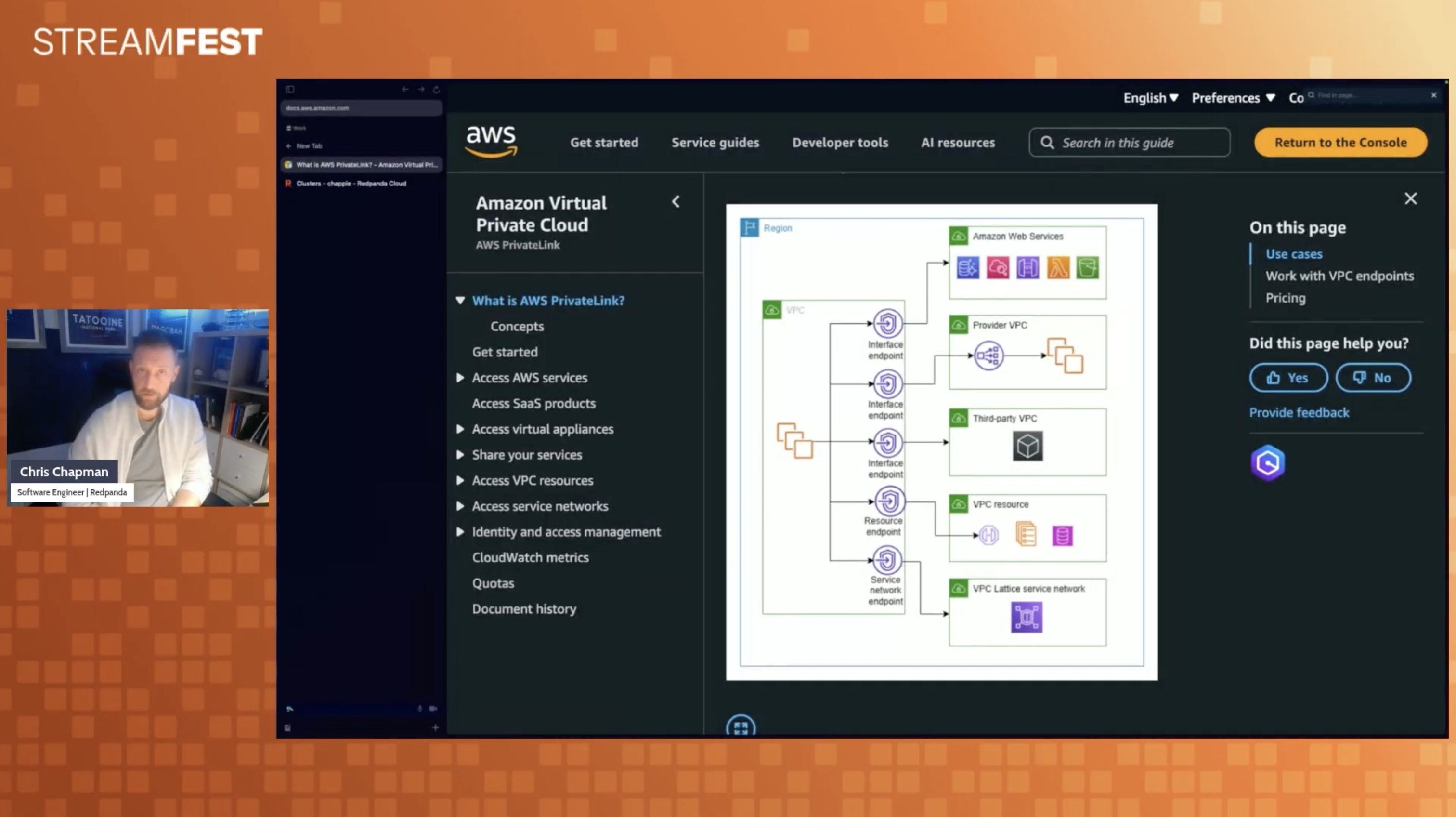
AWS PrivateLink diagram
With our new AWS PrivateLink for Redpanda Serverless, you can keep traffic on private paths when you need it. That means simpler security reviews and a broader fit for regulated industries. It’s the best of serverless streaming, with the networking control enterprises expect.
Interested? Check out Redpanda Serverless to get started.
Customer sessions
Catching up Kafka - Serverless streaming in 2025
Jared Noynaert, VP of Engineering, Crane Worldwide Logistics
If you need more convincing about Serverless, this customer session might do the trick.
Crane Worldwide Logistics is a full-service global freight forwarder and contract logistics provider that offers both air and ocean freight, supported by warehouse solutions, to address supply chain challenges. As one of the fastest-growing logistics companies in the third-party-logistics (3PL) industry, Crane operates 24x7 across 70 countries.
For their technology, that means zero downtime, minimal latency, and high availability.
On that note, Jared, the company’s VP of engineering, had a clear ask for today’s data streaming platforms: faster provisioning, true isolation, and less ops toil — not more tier gymnastics or storage limits.
In other words, platform teams today want serverless streaming.
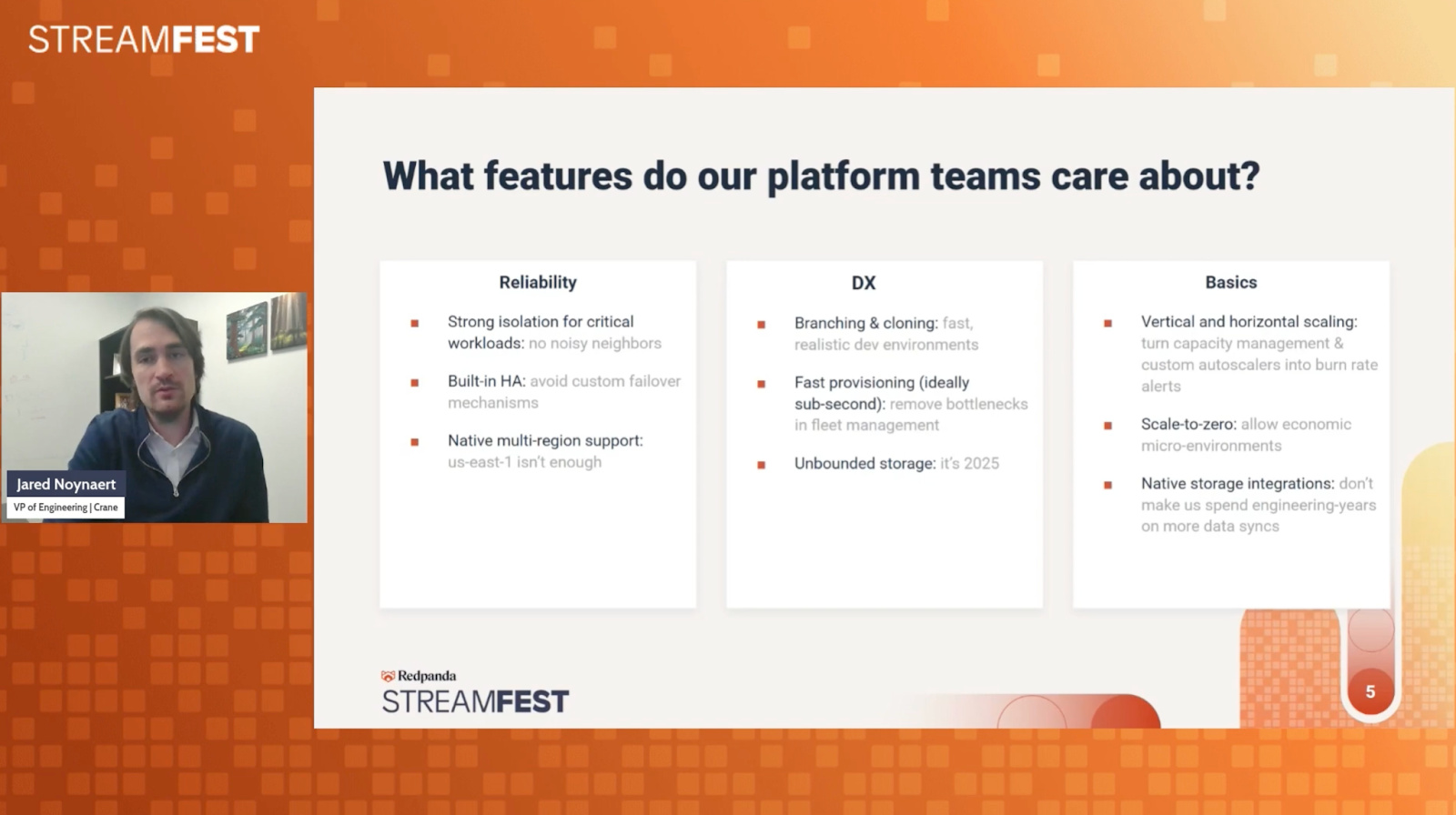
Jared’s platform team priorities
As a happy Redpanda Serverless customer, Crane benefits from a stellar developer experience and a high-productivity environment that helps their small platform team win. But if you want to know how else Jared recommends closing the gap in the current data streaming ecosystem, check out his presentation. Or just go ahead and sign up for Serverless.
A hidden bug in tiered Kafka
Connie Wang, Sr Staff Software Engineer, Rivian
Connie’s session embodies the sentiment of “shaping tomorrow’s knowledge with yesterday’s wisdom,” so if you’re migrating Kafka clusters, you’ll want to pay close attention to this one.
For context, Rivian builds all-electric vehicles with a singular goal: to drive toward a sustainable future. However, as Rivian’s production scaled to thousands of new cars a month, the engineering team realized their self-hosted Kafka cluster was becoming an extremely costly speed bump.

Rivian’s data platform architecture
Naturally, they decided to migrate to a more cost-efficient tiered storage Kafka cluster. Except in the final phase of that migration, they ran into a devastating bug. An “unknown server error” blacked out their screens, and suddenly, multiple brokers and every consumer was down.
Turns out that a single configuration in the tiered storage Kafka cluster was at fault. Knowing something so small could cause so much damage, Rivian cancelled the migration and looked elsewhere. Enter Redpanda, with its cost-efficiency, record-setting performance, and extremely good-looking support team. (They asked me to add that.)
Today, Rivian is happily in production with impressive performance at scale at sustainable cost. Problem solved.
For the full Kafka horror story, check out Connie’s session. To read more customer use cases with happy endings, check out our customer success stories.
Panels
The future of Kafka
Alex Gallego graced the screen to introduce the impressive panel for our “spiciest” session of the day. With experts hailing from Google and Aiven (yes, Aiven), as well as Stan, “The Kafka Guy” (a natural fit for the topic), this panel took attendees on a tour of the biggest questions plaguing the minds of the industry’s best.
The main question being, “Does Apache Kafka have a place in the age of AI?”
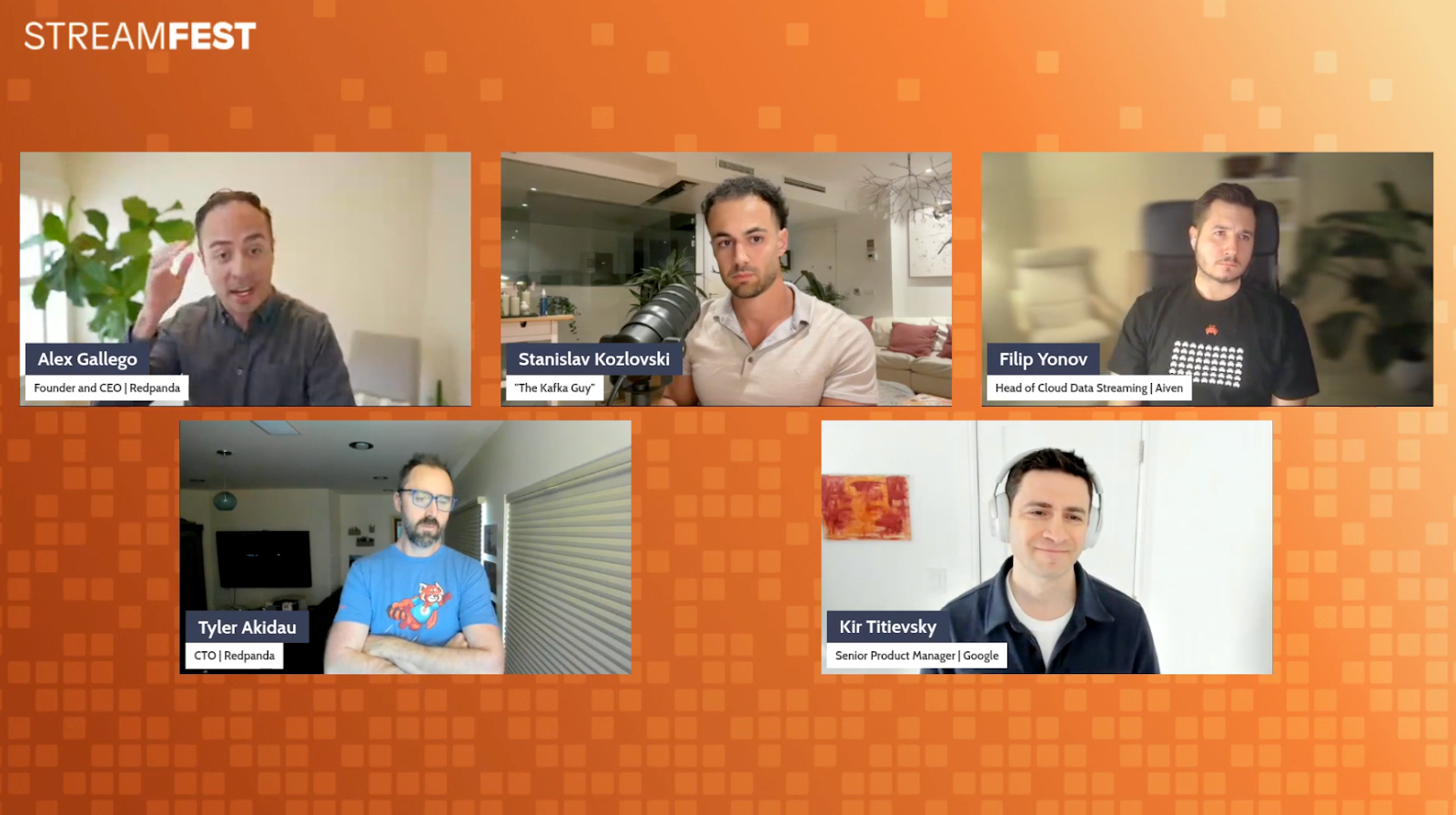
The future of Kafka panel at Streamfest
Stanislav Kozlovski jumped right in to say it doesn’t.
“Kafka is a data protocol, it’s too complex. Kafka was built by experts for experts chasing scale and efficiency. In that pursuit, the tradeoff was simplicity. We can’t expect AI agents to understand it if humans can’t.”
Kir Titievsky (Google) countered that sentiment by saying he thinks Kafka does have a place in generative AI, where he sees the implementation as a “technical challenge and opportunity.” Whether it’s the right protocol, however, is a different question.
The conversation then focused on how each company viewed the future of AI, and took an interesting turn when Filip Yonov (Aiven) pointed out that we’re always asking what will change. But what won’t change?
“While everything about AI is about change, there are certain things that will stay. We still have to make sure our technology is cost-effective, fast, reliable, and open to use.”
Hear hear.
From Inkless to Diskless and everything in between, this panel left no stone unturned. But among the many opinions, one truth rang true for everyone: streaming for AI is still too complex. The experts are excited, but the community can’t fully join in until they understand how to do it with the tools they’re already familiar with. As Stan rightly says, “Community efforts and discussions are key.”
“When the community is united, we can build some epic things.” - Filip Yonov, Aiven
On that note, if you’re looking for a community that’s just as invested in building data streaming and AI applications as you are, then join the Redpanda Community on Slack.
Streams meet Tables: Apache Iceberg panel
Matt Schumpert, our Head of Product (platform), introduced the second panel of the day to discuss another hot topic: Iceberg. Mainly, how has Iceberg changed the way data teams, app engineers, AI and machine learning engineers, and even business analysts handle data?
Jason Reid (Databricks) led the conversation with,
“The big value of data is connecting it across your systems. When we can bring it all together in a single format, everything will be more connected in your business.”
He added that Iceberg “unlocks the analysts,” where they can operate on Iceberg tables with basic SQL and without poking a data engineer. It’s a huge productivity boost. Steven Wu (Snowflake) chimed in that the way Iceberg works breaks down not just technology silos, but also team silos. It brings people together without stepping on each other’s toes.

Apache Iceberg panel at Streamfest
The panel then shifted to the nuances of data lakehouses, topics, and schemas. Will Martin (Dremio) noted, “Marrying streaming and tables is complex for the customer, but you can rely on a solution like Redpanda’s Iceberg Topics or Dremio’s Open Catalog to handle all the plumbing for you.”
Naturally, the chat had to mention AI and where Iceberg fits in to power these applications. Opinions varied, but Melvyn Peignon (ClickHouse) left attendees with a few more questions.
“The key component for agentic AI will be how to handle multimodal data (images, video, etc.) How will we ensure Iceberg supports these formats? How will something that was designed for tabular data adapt to this new data modality that is being needed more and more?”
Food for thought.
**Technical AMA **
Today, two new contenders were in the technical AMA ring, ready to answer any and every question attendees might throw at them.
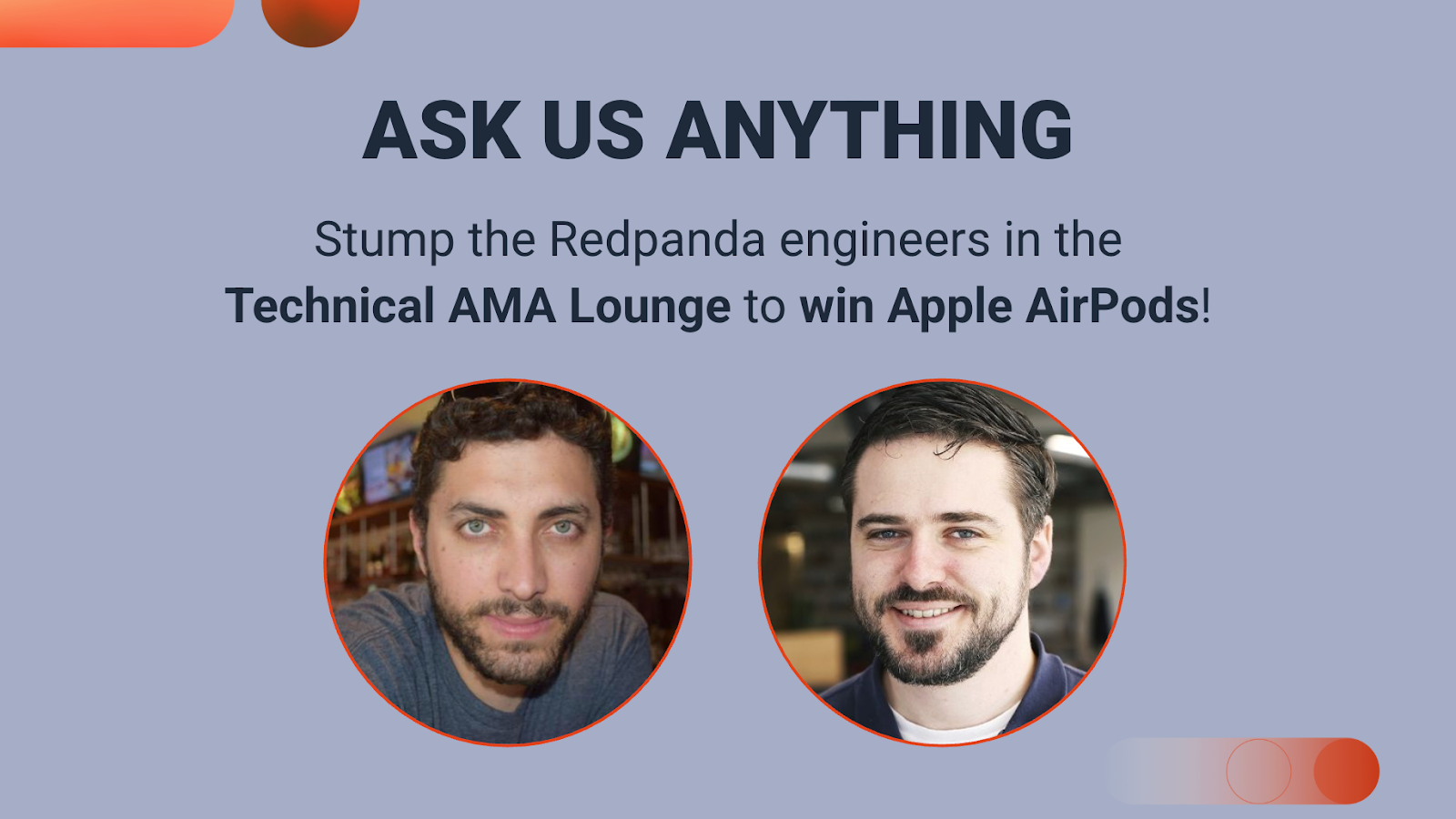
AMA with Camilo Aguilar (left) and Bryan Wood (right)
Attendees certainly did not hold back. Some questions were pure curiosity about the customer issues pandas are working on lately, while others poked around the product and the challenges of migrating from Apache Kafka® to Redpanda, and even how Redpanda handles rebalancing to counter Kafka’s nightmarish issues.
These guys look like they can answer every question you’ve ever had, but they were definitely starting to sweat by the end. You’ll be pleased to know that we did find a winner!
And the winners are…
Streamfest was dotted with opportunities to win swag and other exciting prizes. From stumping our engineers to answering polls, most attendees made their bet with their eyes on the biggest prize: Apple AirPods.
If you missed the live announcement, here are the three lucky winners:
Best technical AMA question: Meng Wu, Principal Engineer at Zillow Most polls answered: Manoj Vasudev, Principal Architect, Bayada. Swathi Sree Durga Mudda, Software Engineer, Charter Communications
Congratulations to the winners! If you didn’t win this time, don’t worry, we’ll be hosting more giveaways and competitions soon enough. Make sure to follow us on LinkedIn, Bluesky, and X so you know where to catch us next.
Relive the magic of Streamfest on demand
That’s a wrap on Redpanda Streamfest 2025! With 20 sessions in two days for over 2,120 global attendees, we can safely say that this year’s event was a huge success.
Now at the finish line, all that’s left is a heartfelt thank you to everyone in the community who made Streamfest a reality. Beyond the curious sessions and Sci-Fi analogies, Streamfest is a genuine reflection of Redpanda’s shared values, innovations, and proudly geeky culture. It’s also living proof that while Redpanda’s technology is built for the AI era, the primary focus will always be on the humans using it.
So whether you’re an expert looking for kindred spirits or a student just finding your footing in the industry, we hope this year’s event inspired you to experiment, collaborate, and create something extraordinary.
Remember, if you missed a session or just want to relive the magic, you can watch Streamfest on demand.
Until we stream again!